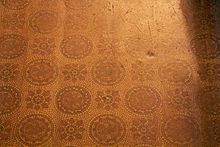Linoleum
Linoleum is a floor covering made from materials such as solidified linseed oil (linoxyn), pine resin, ground cork dust, sawdust, and mineral fillers such as calcium carbonate, most commonly on a burlap or canvas backing.
Cheaper patterned linoleum comes in different grades or gauges, and is printed with thinner layers which are more prone to wear and tear.
Raw linseed oil oxidizes very slowly, but Walton accelerated the process by heating it with lead acetate[clarification needed] and zinc sulfate.
At first, Walton called his invention "Kampticon", which was deliberately close to Kamptulicon, the name of an existing floor covering, but he soon changed it to Linoleum, which he derived from the Latin words linum (flax) and oleum (oil).
The company operated at a loss for its first five years, until Walton began an intensive advertising campaign and opened two shops in London for the exclusive sale of Linoleum.
Walton's friend Jerimiah Clarke designed the linoleum patterns, typically with a Grecian urn motif around the borders.
Walton soon faced competition from other manufacturers, including a company which bought the rights to Parnacott's process, and launched its own floor covering, which it named Corticine, from the Latin cortex (bark or rind).
[citation needed] Walton was unhappy with Michael Nairn & Co's use of the name Linoleum and brought a lawsuit against them for trademark infringement.
[6] Between the time of its invention in 1860 and its being largely superseded by other hard floor coverings in the 1950s, linoleum was considered to be an excellent, inexpensive material for high-use areas.
Its water resistance enabled easy maintenance of sanitary conditions and its resilience made standing easier and reduced breakage of dropped china.
Essentially a highly durable linoleum wall covering, Lincrusta could be manufactured to resemble carved plaster or wood, or even leather.
Inlaid linoleum was made using a stencil type method where different-colored granules were placed in shaped metal trays, after which the sheets were run through heated rollers to fuse them to the backing cloth.
In 1898, Walton devised a process for making straight-line inlaid linoleum that allowed for crisp, sharp geometric designs.
[9] Linoleum is also considered an environmentally friendly alternative to PVC as it is derived from renewable, natural, biodegradable material.





